 W
WThe biological subfamily Bovinae includes a diverse group of 10 genera of medium to large-sized ungulates, including domestic cattle, bison, African buffalo, the water buffalo, and the four-horned and spiral-horned antelopes. The evolutionary relationship between the members of the group is still debated, and their classification into loose tribes rather than formal subgroups reflects this uncertainty. General characteristics include cloven hooves and usually at least one of the sexes of a species having true horns. The largest extant bovine is the gaur.
 W
WThe African buffalo or Cape buffalo is a large sub-Saharan African bovine. Syncerus caffer caffer, the Cape buffalo, is the typical subspecies, and the largest one, found in Southern and East Africa. S. c. nanus is the smallest subspecies, common in forest areas of Central and West Africa, while S. c. brachyceros is in West Africa and S. c. aequinoctialis is in the savannas of East Africa. The adult African buffalo's horns are its characteristic feature: they have fused bases, forming a continuous bone shield across the top of the head referred to as a "boss". It is widely regarded as one of the most dangerous animals on the African continent, and according to some estimates it gores, tramples, and kills over 200 people every year.
 W
WThe African forest buffalo, also known as the dwarf buffalo or the Congo buffalo, is the smallest subspecies of the African buffalo. It is related to the Cape buffalo, the Sudan buffalo, and the Nile buffalo. However, it is the only subspecies that occurs mainly in the rainforests of central and western Africa with an annual rainfall around 1,500 mm.
 W
WAlbino gaur or white bison are a type of gaur, occasionally seen in the Manjampatti Valley, a 110.9 km2 (42.8 sq mi) protected area at the eastern end of Indira Gandhi Wildlife Sanctuary and National Park in Coimbatore District, Tamil Nadu, South India. They are occasionally called Manjampatti white bison. These gaur are notable for their distinctive ash-grey color as opposed to the almost black color of most gaur. Since 1929, there have been at least 19 documented sightings of these rare animals, including the 2004 photographs of N. A. Naseer.
 W
WThe civilization of ancient Egypt was indebted to the Nile River and its dependable seasonal flooding. The river's predictability and fertile soil allowed the Egyptians to build an empire on the basis of great agricultural wealth. Egyptians are credited as being one of the first groups of people to practice agriculture on a large scale. This was possible because of the ingenuity of the Egyptians as they developed basin irrigation. Their farming practices allowed them to grow staple food crops, especially grains such as wheat and barley, and industrial crops, such as flax and papyrus.
 W
WAnoa, also known as dwarf buffalo and sapiutan, are a subgenus of Bubalus comprising two species endemic to the island of Sulawesi in Indonesia: the mountain anoa and the lowland anoa. Both live in undisturbed rainforest and are similar in appearance to miniature water buffalo, weighing 150–300 kg (330–660 lb).
 W
WThe aurochs, also known as urus or ure, is an extinct species of large wild cattle that inhabited Asia, Europe, and North Africa. It is the ancestor of domestic cattle. The species survived in Europe until 1627, when the last recorded aurochs died in the Jaktorów Forest, Poland.
 W
WThe Bali cattle also known as Balinese cattle are a domesticated form of the Javan banteng. Bali cattle were an important source of meat and were used for plowing. Bali cattle are a domestic subspecies originated in Indonesia.
 W
WThe banteng, also known as tembadau, is a species of cattle found in Southeast Asia. The head-and-body length is between 1.9 and 2.25 m. Wild banteng are typically larger and heavier than their domesticated counterparts, but are otherwise similar in appearance. The banteng shows extensive sexual dimorphism; adult bulls are generally dark brown to black, larger and more sturdily built than adult cows, which are thinner and usually pale brown or chestnut red. There is a big white patch on the rump. Horns are present on both sexes, and are typically 60 to 75 cm long. Three subspecies are generally recognised.
 W
WBos is the genus of wild and domestic cattle. Bos can be divided into four subgenera: Bos, Bibos, Novibos, and Poephagus, but including these last three divisions within the genus Bos without including Bison in the genus is believed to be paraphyletic by many workers on the classification of the genus since the 1980s. The genus has five extant species. However, this may rise to eight if the domesticated varieties are counted as separate species, and ten if the closely related genus Bison is also included. Most but not all modern breeds of domesticated cattle are believed to have originated from the extinct aurochs. Many ancient breeds are thought to have originated from other species. Zebus and cows are thought to come from 2 different subspecies of the aurochs the cows come from the European subspecies and the zebu from the Indian subspecies.
 W
WBos palaesondaicus occurred on Pleistocene Java (Indonesia) and belongs to the Bovinae subfamily. It has been described by the Dutch paleoanthropologist Eugène Dubois in 1908. The holotype of Bos palaesondaicus is a skull from Trinil. This species is the likely ancestor to the banteng.
 W
WBoselaphini is a tribe of antelopes belonging to the subfamily Bovinae of the family Bovidae. It contains only two extant genera.
 W
WThe nilgai or blue bull is the largest Asian antelope and is ubiquitous across the northern Indian subcontinent. The sole member of the genus Boselaphus, the species was described and given its binomial name by German zoologist Peter Simon Pallas in 1766. The nilgai stands 1–1.5 metres (3.3–4.9 ft) at the shoulder; males weigh 109–288 kilograms (240–635 lb), and the lighter females 100–213 kilograms (220–470 lb). A sturdy thin-legged antelope, the nilgai is characterised by a sloping back, a deep neck with a white patch on the throat, a short crest of hair along the neck terminating in a tuft, and white facial spots. A column of pendant coarse hair hangs from the dewlap ridge below the white patch. Sexual dimorphism is prominent – while females and juveniles are orange to tawny, adult males have a bluish-grey coat. Only males possess horns, 15–24 centimetres (5.9–9.4 in) long.
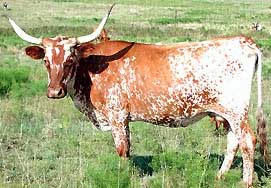 W
WBovina is a subtribe of the Bovini tribe that generally includes the two living genera, Bison and Bos. However, this dichotomy has been challenged recently by molecular work that suggests that Bison should be regarded as a junior synonym of Bos. Wild bovians can be found naturally in North America and Eurasia.
 W
WThe tribe Bovini, or wild cattle are medium to massive bovines that are native to North America, Eurasia, and Africa. These include the enigmatic, antelope-like saola, the African and Asiatic buffalos, and a clade that consists of bison and the wild cattle of the genus Bos. Not only are they the largest members of the subfamily Bovinae, they are the largest species of their family Bovidae. The largest species are the gaur and wild water buffalo, both weighing between 700 and 1,200 kilograms. In addition to their massive size, they can be differentiated from other bovines and bovids with their short, thick legs and smooth horns presented in both sexes.
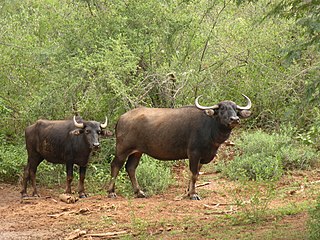 W
WBubalina is a subtribe of wild cattle that includes the various species of true buffalo. Species include the African buffalo, the anoas, and the wild water buffalo. Currently, buffalos can be found naturally in sub-Saharan Africa and southeast Asia, and domestic and feral populations have been introduced to Europe, the Americas, and Australia. In addition to the living species, bubalinans have an extensive fossil record where remains have been found in much of Afro-Eurasia.
 W
WBubalus is a genus of Asiatic bovines that was proposed by Charles Hamilton Smith in 1827. Bubalus and Syncerus form the subtribe Bubalina, the true buffaloes.
 W
WBubalus murrensis, the European water buffalo, is an extinct bovine that lived in Europe during the Pleistocene. Its closest living relatives are the wild water buffalo (Bubalus arnee), the tamaraw (Bubalus mindorensis), the lowland anoa (Bubalus depressicornis), the mountain anoa (Bubalus quarlesi) and the domestic water buffalo (Bubalus bubalis).
 W
WThe carabao is a domestic swamp-type water buffalo native to the Philippines. Despite the popular notion that this bovine has been declared the national animal of the Philippines, the National Commission for Culture and the Arts of the Philippines has stated that this has no basis in Philippine law.
 W
WThe four-horned antelope, or chousingha, is a small antelope found in India and Nepal. This antelope has four horns, which distinguish it from most other bovids, which have two horns. The sole member of the genus Tetracerus, the species was first described by French zoologist Henri Marie Ducrotay de Blainville in 1816. Three subspecies are recognised. The four-horned antelope stands nearly 55–64 centimetres (22–25 in) at the shoulder and weighs nearly 17–22 kilograms (37–49 lb). Slender with thin legs and a short tail, the four-horned antelope has a yellowish brown to reddish coat. One pair of horns is located between the ears, and the other on the forehead. The posterior horns are always longer than the anterior horns, which might be mere fur-covered studs. While the posterior horns measure 8–12 centimetres (3.1–4.7 in), the anterior ones are 2–5 centimetres (0.79–1.97 in) long.
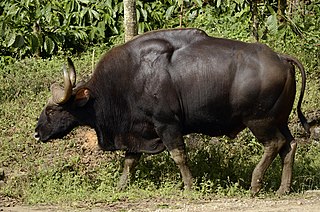 W
WThe gaur, also known as Indian bison, is native to South and Southeast Asia and has been listed as Vulnerable on the IUCN Red List since 1986. The global population has been estimated at maximum 21,000 mature individuals by 2016. It declined by more than 70% during the last three generations, and is extinct in Sri Lanka and probably also in Bangladesh. Populations in well-protected areas are stable and increasing.
 W
WThe gayal, also known as mithun in Myanmar, is a large domestic bovine distributed in Northeast India, Bangladesh, Myanmar and in Yunnan, China.
 W
WHemibos is an extinct even-toed ungulate belonging to the family Bovidae. Its fossil remains were found across Asia and Europe such as from China, Italian Peninsula, Iberian Peninsula, and State of Palestine, Israel, Pakistan, India.
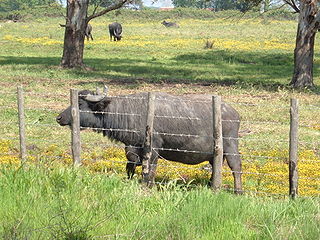 W
WThe Italian Mediterranean Buffalo is an Italian breed of water buffalo. It is of the River sub-type of water buffalo and is similar to the buffalo breeds of Hungary, Romania and the Balkan countries. It is the only indigenous water buffalo breed in Italy. A herd-book was opened in 1980, and the breed was officially recognised in 2000.
 W
WThe kouprey is a little-known, forest-dwelling, wild bovine species native to Southeast Asia. A young male was sent to the Vincennes Zoo in 1937 where it was described by the French zoologist Achille Urbain and was declared the holotype. The kouprey has a tall, narrow body, long legs, a humped back and long horns.
 W
WThe nilgai or blue bull is the largest Asian antelope and is ubiquitous across the northern Indian subcontinent. The sole member of the genus Boselaphus, the species was described and given its binomial name by German zoologist Peter Simon Pallas in 1766. The nilgai stands 1–1.5 metres (3.3–4.9 ft) at the shoulder; males weigh 109–288 kilograms (240–635 lb), and the lighter females 100–213 kilograms (220–470 lb). A sturdy thin-legged antelope, the nilgai is characterised by a sloping back, a deep neck with a white patch on the throat, a short crest of hair along the neck terminating in a tuft, and white facial spots. A column of pendant coarse hair hangs from the dewlap ridge below the white patch. Sexual dimorphism is prominent – while females and juveniles are orange to tawny, adult males have a bluish-grey coat. Only males possess horns, 15–24 centimetres (5.9–9.4 in) long.
 W
WProtragocerus is an extinct genus of antelope from the late Serravallian Age of the Miocene Epoch. Fossils of the genus have been found in France, Kenya, India, and Saudi Arabia. It is classified under the tribe Boselaphini, subfamily Bovinae of the family Bovidae. The genus was first established by the French paleontologist Charles Depéret in 1887.
 W
WA re'em, also reëm, is an animal mentioned nine times in the Hebrew Bible and variously translated as a unicorn or a wild ox. It was first identified in modern times with the aurochs by Johann Ulrich Duerst, who discovered it was based on the Akkadian cognate rimu, meaning Bos primigenius, the aurochs, progenitor of cattle. This has been generally accepted, as it is today even among religious scholars. It has been translated in some Christian Bible translations as "oryx" and as "unicorn" in the King James Version, possibly referring to a one-horned rhinoceros such as Rhinoceros unicornis.
 W
WThe saola, also called siola, Vu Quang ox, spindlehorn, Asian unicorn, or, infrequently, the Vu Quang bovid, is one of the world's rarest large mammals, a forest-dwelling bovine found only in the Annamite Range of Vietnam and Laos. Related to cattle, goats, and antelopes, the species was described following a discovery of remains in 1992 in Vũ Quang Nature Reserve by a joint survey of the Vietnamese Ministry of Forestry and the World Wide Fund for Nature. Saolas have since been kept in captivity multiple times, although only for short periods. A living saola in the wild was first photographed in 1999 by a camera trap set by WWF and the Vietnamese government's Forest Protection Department (SFNC).
 W
WThe African buffalo or Cape buffalo is a large sub-Saharan African bovine. Syncerus caffer caffer, the Cape buffalo, is the typical subspecies, and the largest one, found in Southern and East Africa. S. c. nanus is the smallest subspecies, common in forest areas of Central and West Africa, while S. c. brachyceros is in West Africa and S. c. aequinoctialis is in the savannas of East Africa. The adult African buffalo's horns are its characteristic feature: they have fused bases, forming a continuous bone shield across the top of the head referred to as a "boss". It is widely regarded as one of the most dangerous animals on the African continent, and according to some estimates it gores, tramples, and kills over 200 people every year.
 W
WThe tamaraw or Mindoro dwarf buffalo is a small hoofed mammal belonging to the family Bovidae. It is endemic to the island of Mindoro in the Philippines, and is the only endemic Philippine bovine. It is believed, however, to have once also thrived on the larger island of Luzon. The tamaraw was originally found all over Mindoro, from sea level up to the mountains, but because of human habitation, hunting, and logging, it is now restricted to only a few remote grassy plains and is now a critically endangered species.
 W
WTaurotragus is a genus of large antelopes of the African savanna, commonly known as elands. It contains two species: the common eland T. oryx and the giant eland T. derbianus.
 W
WThe tribe Tragelaphini, or the spiral-horned antelopes, are bovines that are endemic to sub-Sahara Africa. These include the bushbuck, kudus, and the elands. The scientific name is in reference to the mythical creature the tragelaph, a Chimera with the body of a stag and the head of a goat. They are medium-to-large, tall, long-legged antelopes characterized by their iconic twisted horns and striking pelage coloration patterns.
 W
WTragelaphus is a genus of medium- to large-sized spiral-horned antelopes. It contains several species of bovine, all of which are relatively antelope-like. Species in this genus tend to be large sized, lightly built, have long necks and considerable sexual dimorphism. Elands, including the common eland, are embedded within this genus meaning that Taurotragus must be subsumed into Tragelaphus to avoid paraphyly. Alternatively, Taurotragus could be maintained as a separate genus, if the nyala and the lesser kudu are relocated to their own monospecific genera: respectively, Nyala and Ammelaphus. Other generic synonyms include Strepsiceros and Boocercus. The name "Tragelaphus" comes from the mythical tragelaph.
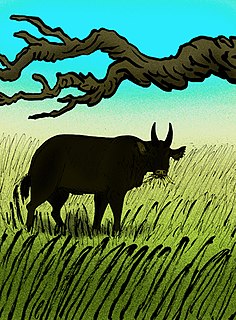 W
WUgandax is an extinct genus of bovines in the subtribe Bubalina that lived from the Miocene to the Pleistocene of Africa. Cladistic analyses suggest Ugandax represents an ancestral form of the African buffalo, Synceros, and teeth assigned to Ugandax represent the earliest appearance of bovines in Africa.
 W
WThe wild yak is a large, wild type of cattle native to the Himalayas. It is the ancestor of the domestic yak.
 W
WThe domestic yak is a long-haired domesticated cattle found throughout the Himalayan region of the Indian subcontinent, the Tibetan Plateau, Northern Myanmar, Yunnan, Sichuan and as far north as Mongolia and Siberia. It is descended from the wild yak.